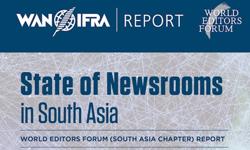Trends in Newsrooms 2015 examines the issues occupying the minds and work of editors all over the world. In addition to the trends that emerged on the WEF's editorsweblog.org, the report includes the insights from more than 50 editors and senior journalists.
Among the issues included are:
* New Convergence: Where games, virtual reality and wearables meet news. There is a growing movement to combine two seemingly incompatible industries: gaming and the news. The "gamification" of news, where video game technology and practices are used in conjunction with traditional journalism methods, is attracting renewed interest from newsrooms around the world. Media organizations including the BBC, the Guardian and the New York Times have all created their own news games in recent years, while BuzzFeed recently announced the creation of a gaming team devoted to creating content for the site.
* Source Protection Erosion: the rising threat to investigative journalism. It used to be possible to promise confidentiality to sources -- guaranteeing the protection of their identities, even on pain of jail – in countries where legal source protection frameworks were robust. But these protections are being undercut by government surveillance and data retention policies, and it may no longer be ethically possible to promise confidentiality. These developments have an enormous impact on investigative journalism and are giving rise to increasing attention to risk assessment, self-protection and source education.
* The Rise of the Robots – welcome to your automated news future. The Associated Press has hired an Automation Editor, a first for the industry. Automated reports on routine economic news is becoming more common, and the AP has announced it will use automated reporting to cover thousands of college sports games that would otherwise not be covered.
* Journalism After Charlie – lessons learned as the shockwaves continue. The Charlie Hebdo attack in central Paris graphically demonstrated that journalists continue to be terrorism targets – at their desks as well as in war zones. It created a new set of safety crises for newsrooms, and it put press freedom on the front page internationally. But it also highlighted the need for culturally sensitive reporting; the disparity between coverage of terrorism attacks affecting the West and those that plague developing countries; the threat of government censorship.
Trends in Newsrooms is available free to members of the World Editors Forum and the World Association of Newspapers and News Publishers (WAN-IFRA), and for purchase by non-members. Full details can be found here.












